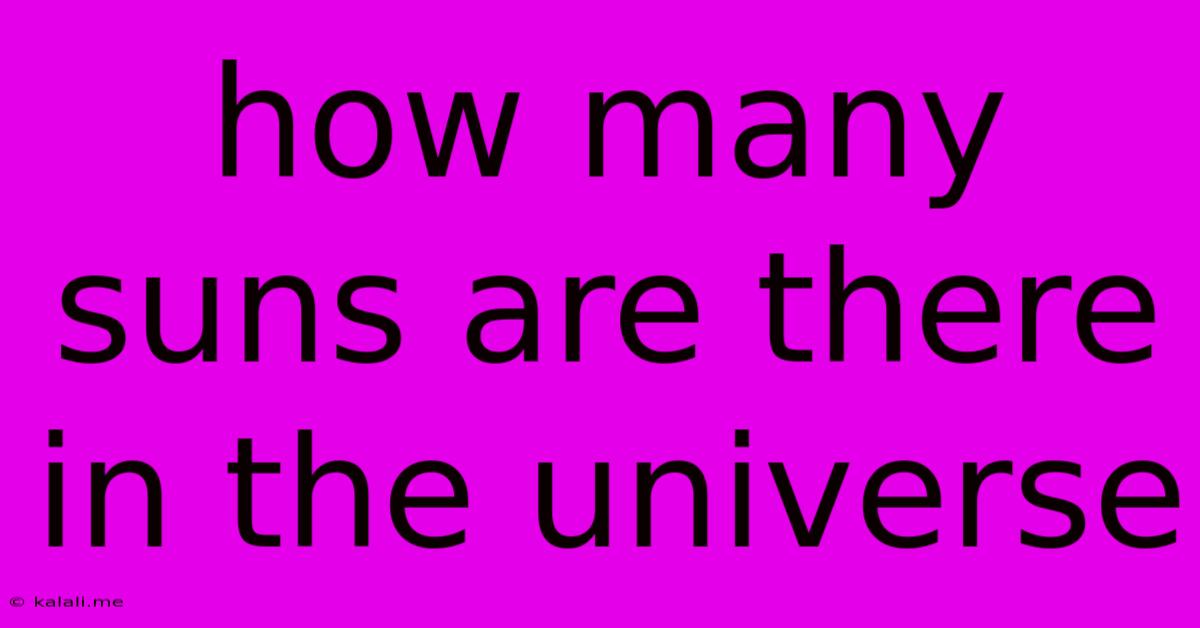How Many Suns Are There In The Universe
Kalali
May 21, 2025 · 3 min read

Table of Contents
How Many Suns Are There in the Universe? A Deep Dive into Stellar Populations
The seemingly simple question, "How many suns are there in the universe?", unveils a breathtakingly vast and complex answer. While we can't provide an exact number, we can explore the incredible scale of stellar populations and the methods astronomers use to estimate this unfathomable quantity. This article delves into the science behind star counts, discusses different types of stars, and considers the limitations of our current understanding.
Understanding the Immensity of the Universe
The universe is staggeringly large, encompassing billions of galaxies, each containing billions – sometimes trillions – of stars. These stars, like our Sun, are giant balls of plasma undergoing nuclear fusion, generating light and heat. Our Sun, a G-type main-sequence star, is just one among countless others, varying in size, temperature, and age. Trying to count them all is a monumental task, akin to counting grains of sand on all the beaches of Earth.
Estimating the Number of Stars:
Scientists use various methods to estimate the number of stars in the observable universe. These include:
-
Galaxy Surveys: Large-scale surveys like the Sloan Digital Sky Survey meticulously map galaxies, providing data on their size, shape, and luminosity. By analyzing the distribution of galaxies and the average number of stars per galaxy, astronomers can extrapolate to estimate the total number of stars.
-
Star Formation Rates: Scientists observe the rate at which new stars are born in different regions of space. Combining this information with the lifespan of stars helps estimate the total number of stars that have existed throughout cosmic history.
-
Extrapolation from Observable Data: The observable universe is only a portion of the entire universe. Scientists extrapolate from the observable portion, assuming a roughly uniform distribution of stars, to estimate the total number in the unobservable regions. This, however, is fraught with uncertainty.
Types of Stars and Their Distribution:
The universe is not populated by only one type of star. We find a vast diversity, including:
-
Main Sequence Stars: These are the most common type, including our Sun, fusing hydrogen into helium.
-
Red Giants: These are evolved stars that have exhausted their core hydrogen fuel.
-
White Dwarfs: These are the remnants of low-mass stars, incredibly dense and slowly cooling.
-
Neutron Stars: These are incredibly dense remnants of massive stars, formed after supernova explosions.
-
Black Holes: These are regions of spacetime with such strong gravity that nothing, not even light, can escape.
The distribution of these different star types varies across different galaxies and galactic environments, adding further complexity to star counting.
The Limitations and Uncertainties:
Estimating the number of stars in the universe is inherently uncertain due to several factors:
-
Observable Universe Limitations: We can only observe a limited portion of the universe due to the finite speed of light and the expansion of the universe.
-
Distribution Inhomogeneities: The distribution of galaxies and stars is not perfectly uniform. Large-scale structures and voids influence estimations.
-
Uncertainties in Galaxy Properties: Estimating the number of stars per galaxy relies on models and assumptions about galactic properties that may not always be perfectly accurate.
Conclusion:
While a precise number remains elusive, estimates place the number of stars in the observable universe in the range of 10<sup>22</sup> to 10<sup>24</sup>. This is an incomprehensibly vast number, highlighting the sheer scale and complexity of the cosmos. As our observational techniques improve and our understanding of the universe deepens, future research may refine these estimates. However, the profound mystery and wonder of the cosmos remain, a testament to the enduring quest to understand our place within it.
Latest Posts
Latest Posts
-
Format Usb To Ext3 Mac Os
May 23, 2025
-
How To Express Trace In Equation Latex
May 23, 2025
-
How Do You Say How Long In Spanish
May 23, 2025
-
Wordpress Get Attachment Parent Post By Id
May 23, 2025
-
Why Are French People Called Frogs
May 23, 2025
Related Post
Thank you for visiting our website which covers about How Many Suns Are There In The Universe . We hope the information provided has been useful to you. Feel free to contact us if you have any questions or need further assistance. See you next time and don't miss to bookmark.